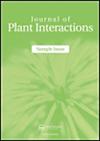木醋可减轻丁香假单胞菌的光合抑制和氧化损伤。烟草叶片中的烟粉虱(Pst)感染
IF 3.3
3区 生物学
Q2 PLANT SCIENCES
引用次数: 0
摘要
摘要利用叶绿素荧光技术和生物化学方法,分析了木醋(WV)对丁香假单胞菌(Pseudomonas syringae pv)感染烟草(Nicotiana tabacum L.)叶片光合机制和活性氧代谢的影响。烟草(Pst)。结果表明,Pst感染降低了烟叶的叶绿素含量,降低了PSII和PSI的活性,抑制了烟叶的正常光合作用。然而,WV预处理减轻了叶绿素的降解。WV处理减轻了PSII和PSI核心基因表达的下调,并改善了Pst感染叶片的光合电子传递。经WV预处理的Pst感染叶片中PetE、ATPa和ATPc的表达水平显著上调。Pst感染增加了超氧阴离子的产生率和过氧化氢的含量。WV预处理可以通过提高过氧化物酶(POD)和谷胱甘肽过氧化物酶(GPx)的活性以及上调POD2和GPX2基因的表达水平来消除Pst感染叶片的氧化损伤。总之,WV预处理可以减轻Pst感染对烟草叶片的光合抑制和氧化损伤。本文章由计算机程序翻译,如有差异,请以英文原文为准。
Wood vinegar alleviates photosynthetic inhibition and oxidative damage caused by Pseudomonas syringae pv. tabaci (Pst) infection in tobacco leaves
ABSTRACT We used chlorophyll fluorescence technology and biochemical methods to analyze the effects of wood vinegar (WV) on the photosynthetic mechanism and reactive oxygen species metabolism of tobacco (Nicotiana tabacum L.) leaves infected by Pseudomonas syringae pv. tabaci (Pst). The results showed that Pst infection reduced the chlorophyll content and the activities of PSII and PSI, which inhibited the normal photosynthesis of tobacco leaves. However, pretreatment with WV alleviated the degradation of chlorophyll. Treatment with WV alleviated the downregulation of core gene expression in PSII and PSI and improved the photosynthetic electron transfer in Pst-infected leaves. The levels of expression of PetE, ATPa and ATPc in the Pst-infected leaves were significantly upregulated when pretreated with WV. Pst infection increased the rate of production of superoxide anions and the contents of hydrogen peroxide. WV pretreatment could eliminate the oxidative damage of Pst-infected leaves by enhancing the activities of peroxidase (POD) and glutathione peroxidase (GPx) and upregulating the levels of expression of the POD2 and GPX2 genes. In conclusion, pretreatment with WV can alleviate the photosynthetic inhibition and oxidative damage of tobacco leaves caused by Pst infection.
求助全文
通过发布文献求助,成功后即可免费获取论文全文。
去求助
来源期刊

Journal of Plant Interactions
PLANT SCIENCES-
CiteScore
5.30
自引率
6.20%
发文量
69
审稿时长
>12 weeks
期刊介绍:
Journal of Plant Interactions aims to represent a common platform for those scientists interested in publishing and reading research articles in the field of plant interactions and will cover most plant interactions with the surrounding environment.
 求助内容:
求助内容: 应助结果提醒方式:
应助结果提醒方式:


